- A+
滴咚,大家好久不见?。好就没写东西了,鸽着鸽着就无了?。。。
回到正题,上篇文章说完命令提了一嘴MVVM模式直接就上MVVMLight这些程序的框架了,虽然也没说多少,但还是有点不好过渡,这篇对MVVM做一些系统学习,同时复习一下前几篇博文中的内容,完成一个采用MVVM模式的示例Demo。
? 小插曲
给N早之前文章中的可能混淆的内容做下说明 - 关于WPF 入门笔记 - 04 - 数据绑定 - OneWayToSource 文本框爆红现象:
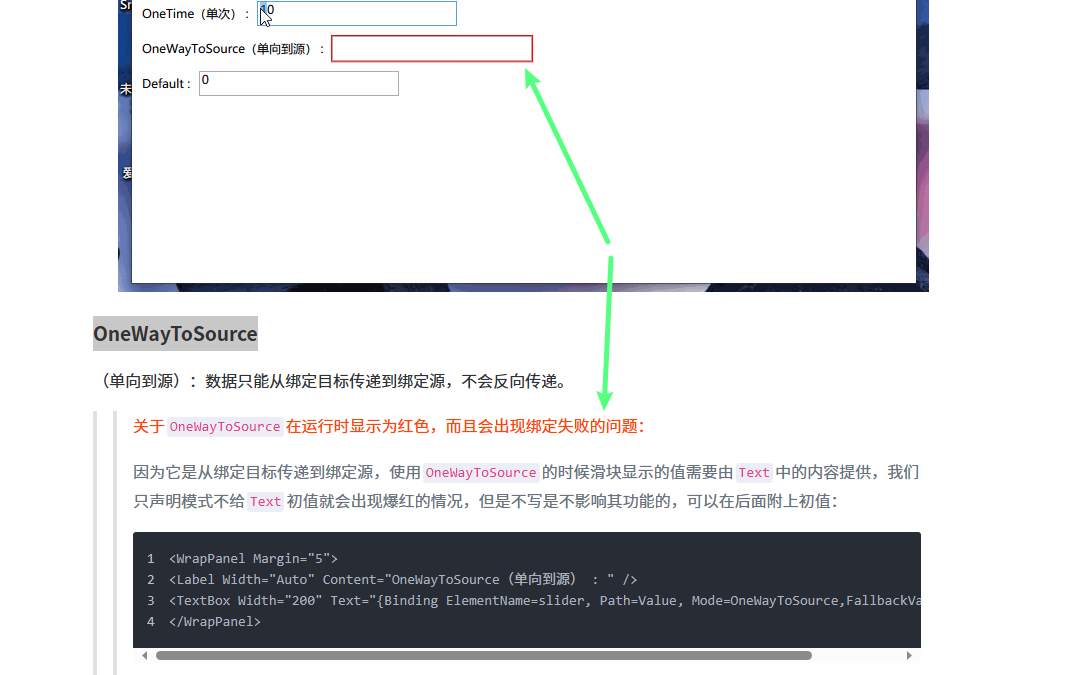
- 在那篇文章一开始给初值是没问题的,因为
OneWayToSource是将数据从绑定目标传递到绑定源,所以不给初值一定会出现绑定失败的问题 - 文本框爆红我觉得和绑定模式没有关系,我猜测和文本框绑定的数据类型有关,假设文本框绑定的是支持为空的
string类型的字符串,它是空的话是不会爆红的,因为空会转化成"",但如果绑定的数据类型是不能为空的int类型,就会在文本框没有内容时出现爆红现象,同时会出现绑定失败
应该是这样,不对的话记得在评论区实现INotifyPropertyChanged接口教教我噢?
? 什么是MVVM
MVVM 是 Model-View-ViewModel 的缩写,是一种用于构建用户界面的设计模式,由微软 WPF 和 Silverlight 的架构师 Ken Cooper 和 Ted Peters 开发,是一种简化用户界面的事件驱动编程方式。它在 WPF 和其他 XAML-based 技术中广泛应用,比如UWP、采用XAML的MAUI APP,在前端开发也比较常见。MVVM 的目标是实现用户界面和业务逻辑之间的彻底分离,以便更好地管理和维护应用程序,并提供更好的可测试性和可扩展性。
MVVM 模式包含以下三个核心组件:
Model(模型):Model代表应用程序的数据和业务逻辑。它负责存储和管理数据,并且通常不包含任何与用户界面相关的代码。Model可以是数据实体、数据库访问类、服务类等。View(视图):View是用户界面的可视化表示,通常由XAML文件定义。它负责展示数据给用户,并捕获用户输入。View并不处理业务逻辑,而是通过绑定和命令将用户操作传递给ViewModel。ViewModel(视图模型):ViewModel是View和Model之间的桥梁,负责处理View与Model之间的交互。它将Model中的数据转换为View所需的数据,并处理用户输入、命令和其他交互逻辑。ViewModel通常实现了INotifyPropertyChanged接口,用于通知View当数据发生变化时进行更新。

MVVM 的基本原则是让 View 和 Model 完全解耦,它们之间通过 ViewModel 进行通信。View 通过数据绑定将 ViewModel 中的数据展示给用户,通过命令绑定将用户的操作传递给 ViewModel。ViewModel 则通过数据绑定和命令绑定将用户输入转换为对 Model 的操作,从而实现业务逻辑的处理。
回到 WPF 里,View就是用xaml描绘的页面,负责与用户交互,响应用户操作,展示数据给用户;ViewModel负责收集需要绑定的数据和命令,通过 View 的 DataContext 属性绑定到 View,同时处理UI逻辑;Model 就作为系统中的对象,包含数据对象。
一个 View 对应一个 ViewModel ,一个 ViewModel 可以聚合多个 Model,ViewModel 可以对应多个 View,在 MVVM 下,所有事件和动作都转换成命令,如按钮的点击操作,不在是触发点击事件,而是绑定到命令,由命令去执行对应的逻辑。
MVVM 模式的优势包括:
- 分离关注点:
MVVM将用户界面逻辑和业务逻辑彻底分开,使代码结构更清晰,易于理解和维护。 - 可测试性:由于
View和ViewModel之间的解耦,可以更轻松地对ViewModel进行单元测试,而无需涉及到用户界面的操作。 - 可扩展性:
MVVM支持模块化开发,不同的View和ViewModel可以独立开发和组合,使应用程序更易于扩展。 - 可重用性:
ViewModel可以与不同的View进行重用,从而减少了重复编写代码的工作。
? 简单MVVM
学习一下 MSDN - .NET MAUI 数据绑定和 MVVM 中的 简单MVVM 章节,是一个.NET MAUI的 ContentPage,用来显示时间,Maui 和 WPF 在命名空间上是有点不一样的:
Part 1
<Window x:Class="OneShotDateTimeDemo.MainWindow" xmlns="http://schemas.microsoft.com/winfx/2006/xaml/presentation" xmlns:x="http://schemas.microsoft.com/winfx/2006/xaml" xmlns:d="http://schemas.microsoft.com/expression/blend/2008" xmlns:local="clr-namespace:OneShotDateTimeDemo" xmlns:mc="http://schemas.openxmlformats.org/markup-compatibility/2006" xmlns:sys="clr-namespace:System;assembly=mscorlib" Title="One-Shot DateTime Page" Width="800" Height="450" WindowStartupLocation="CenterScreen" mc:Ignorable="d"> <Grid> <StackPanel HorizontalAlignment="Center" VerticalAlignment="Center" DataContext="{x:Static sys:DateTime.Now}"> <TextBlock Text="{Binding Year, StringFormat='The year is {0}'}" /> <TextBlock Text="{Binding StringFormat='The month is {0:MMMM}'}" /> <TextBlock Text="{Binding Day, StringFormat='The day is {0}'}" /> <TextBlock Text="{Binding StringFormat='The time is {0:T}'}" /> </StackPanel> </Grid> </Window> 这段 Xaml 在 StackPanel 的 DataContext 中设置了一个绑定到当前日期和时间的 DateTime 对象,然后通过数据绑定将 DateTime 对象的各个属性显示在不同的子元素 TextBlock 中,同时对显示内容进行了格式化。
运行程序,文本中的日期和时间只会在构造和初始化的时候设置一次,不会随时间的变化而变化。
示例中是
Label,我这里换成了TextBlock,因为Label在Binding中使用StringFormat不生效【哦,我用的方法不对,Label不能用StringFormat?】:
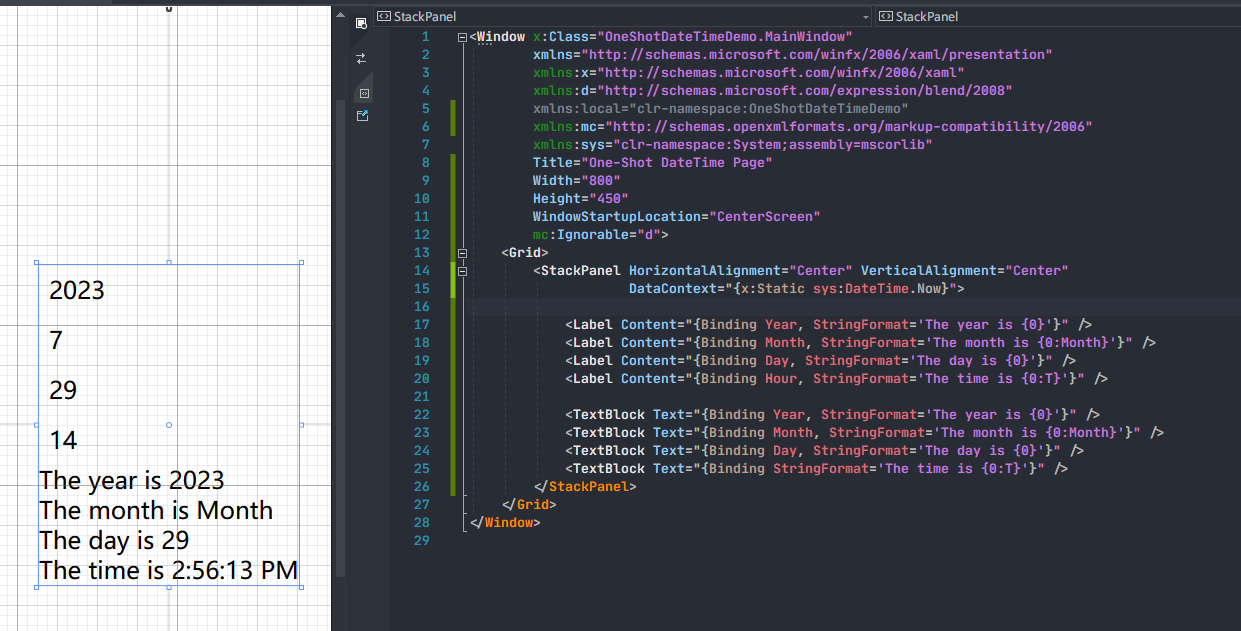
Part 2
上面的页面写出来显然是没有意义的,我们想让它实时显示当前时间,这就需要有个东西在时间发生变化时一直更新页面上的时间,这个过程一般会通过后台代码完成,当然可以通过一个 Timer 搞定,但就和这篇文章的内容没关系了,用 MVVM 的模式怎么实现呢?
首先从 MVVM 三部分来看,View 就是标题为 One-Shot DateTime Page 的窗体,Model 是 DateTime 对象,需要 ViewModel 来处理时间数据同时通知页面响应更改。
创建一个ClockViewModel.cs类:
using System; using System.ComponentModel; using System.Runtime.CompilerServices; using System.Threading; namespace OneShotDateTimeDemo { public class ClockViewModel : INotifyPropertyChanged { public event PropertyChangedEventHandler PropertyChanged; private DateTime _dateTime; private Timer _timer; public DateTime DateTime { get => _dateTime; set { if (_dateTime != value) { _dateTime = value; OnPropertyChanged(); } } } public ClockViewModel() { DateTime = DateTime.Now; _timer = new Timer(new TimerCallback((s) => DateTime = DateTime.Now), null, TimeSpan.Zero, TimeSpan.FromSeconds(1)); } ~ClockViewModel() => _timer.Dispose(); public void OnPropertyChanged([CallerMemberName] string name = "") { PropertyChanged?.Invoke(this, new PropertyChangedEventArgs(name)); } } } ClockViewModel 类实现了 INotifyPropertyChanged 接口,并通过 Timer 定时更新时间并触发属性更改通知,提供实时的系统时间。完成 ViewModel 部分以后,将 ViewModel 绑定到视图 View - MainWindow 上:
<Window x:Class="OneShotDateTimeDemo.MainWindow" xmlns="http://schemas.microsoft.com/winfx/2006/xaml/presentation" xmlns:x="http://schemas.microsoft.com/winfx/2006/xaml" xmlns:d="http://schemas.microsoft.com/expression/blend/2008" xmlns:local="clr-namespace:OneShotDateTimeDemo" xmlns:mc="http://schemas.openxmlformats.org/markup-compatibility/2006" xmlns:sys="clr-namespace:System;assembly=mscorlib" Title="One-Shot DateTime Page" Width="800" Height="450" WindowStartupLocation="CenterScreen" mc:Ignorable="d"> <Window.DataContext> <local:ClockViewModel /> </Window.DataContext> <Grid> <Grid.RowDefinitions> <RowDefinition /> <RowDefinition /> </Grid.RowDefinitions> <StackPanel HorizontalAlignment="Center" VerticalAlignment="Center" DataContext="{x:Static sys:DateTime.Now}"> <TextBlock Text="{Binding Year, StringFormat='The year is {0}'}" /> <TextBlock Text="{Binding StringFormat='The month is {0:MMMM}'}" /> <TextBlock Text="{Binding Day, StringFormat='The day is {0}'}" /> <TextBlock Text="{Binding StringFormat='The time is {0:T}'}" /> </StackPanel> <StackPanel Grid.Row="1" HorizontalAlignment="Center" VerticalAlignment="Center"> <TextBlock Text="{Binding DateTime, StringFormat='The time is {0:T}'}" /> </StackPanel> </Grid> </Window> 这样就可以得到一个 MVVM 模式下的时钟了:
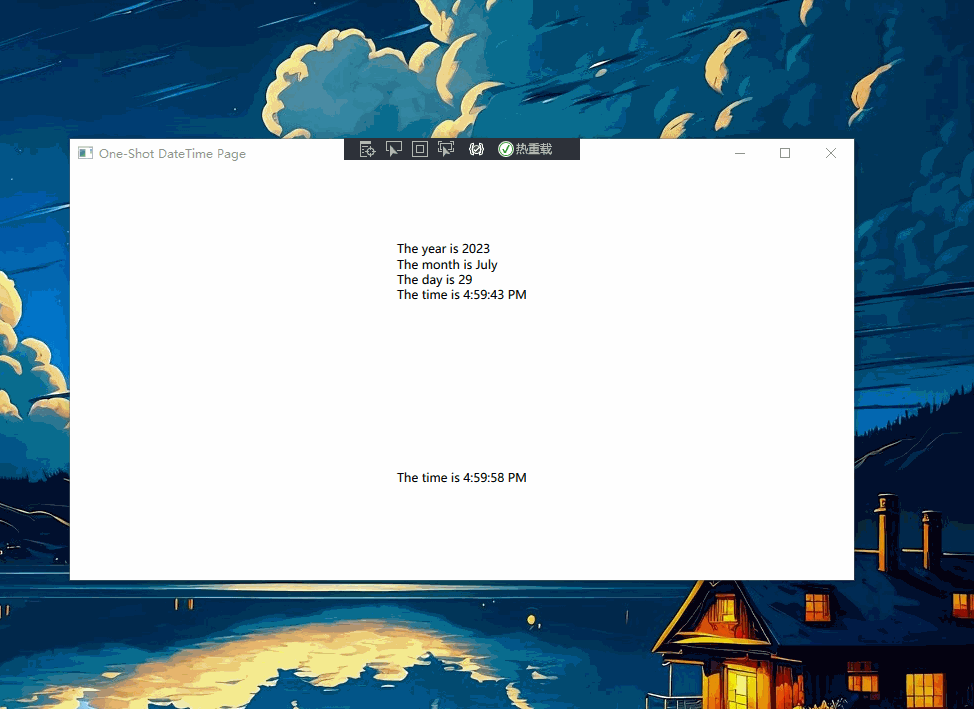
以上就是一个简单的MVVM的示例,功能比较简单,只涉及到了属性变动,无关乎用户操作。【时间更新肉眼可见的有问题?】
? 完整MVVM
接下来完成一个完整的MVVM示例,内容参考自博主丑萌气质狗在B站发布的WPF入门视频,大家可以取搜一下找来看看。内容比较基础,但同时讲解也非常细腻,碎碎念教学,哈哈哈。有些基础但不多的小伙伴可以去看一下?
登录页面UI
回到正题,示例是一个简单的登录页面的MVVM实现,用界面部分来回顾下之前学习的内容:
MainView.xaml -为了方便区分每部分扮演的角色,给MainWindow.xaml改了个名:
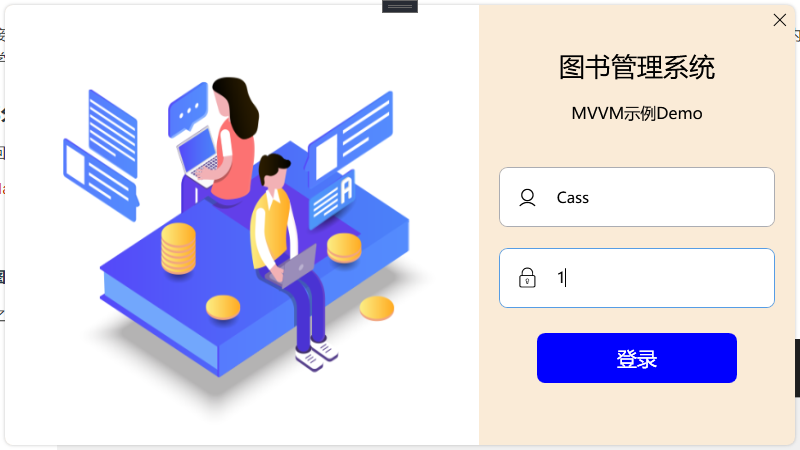
登录页面是这样设计的,窗体取消了默认的标题栏,调整为带阴影的圆角窗体,左侧放一张登录背景图,右边自绘了一个关闭按钮,文本框和按钮也做了美化。快速来看一下如何实现的。
窗体设置
窗口样式调整为None,不允许调整窗口大小,用Border包裹整个窗体实现圆角以及阴影效果,整体分两部分 - 左侧图片、右侧背景图:
<Window x:Class="MVVMDemo.MainView" xmlns="http://schemas.microsoft.com/winfx/2006/xaml/presentation" xmlns:x="http://schemas.microsoft.com/winfx/2006/xaml" xmlns:d="http://schemas.microsoft.com/expression/blend/2008" xmlns:local="clr-namespace:MVVMDemo" xmlns:mc="http://schemas.openxmlformats.org/markup-compatibility/2006" Title="MainView" Width="800" Height="450" AllowsTransparency="True" Background="{x:Null}" ResizeMode="NoResize" WindowStartupLocation="CenterScreen" WindowStyle="None" mc:Ignorable="d"> <Border Margin="5" Background="AntiqueWhite" CornerRadius="8"> <Border.Effect> <DropShadowEffect BlurRadius="5" Direction="0" Opacity="0.3" ShadowDepth="0" Color="Gray" /> </Border.Effect> <Grid> <Grid.ColumnDefinitions> <ColumnDefinition Width="6*" /> <ColumnDefinition Width="4*" /> </Grid.ColumnDefinitions> <Border CornerRadius="8,0,0,8"> <Border.Background> <ImageBrush ImageSource="./Assets/Images/LoginBackground.png" Stretch="Fill" /> </Border.Background> </Border> <Border Grid.Column="1" CornerRadius="0,8,0,8"> ... // 内容部分 </Border> </Grid> </Border> </Window> 字体图标
之前笔记中有说,这里复习以下。去阿里巴巴矢量图标库选好要用的图标,添加入库,然后从库里添加至项目:
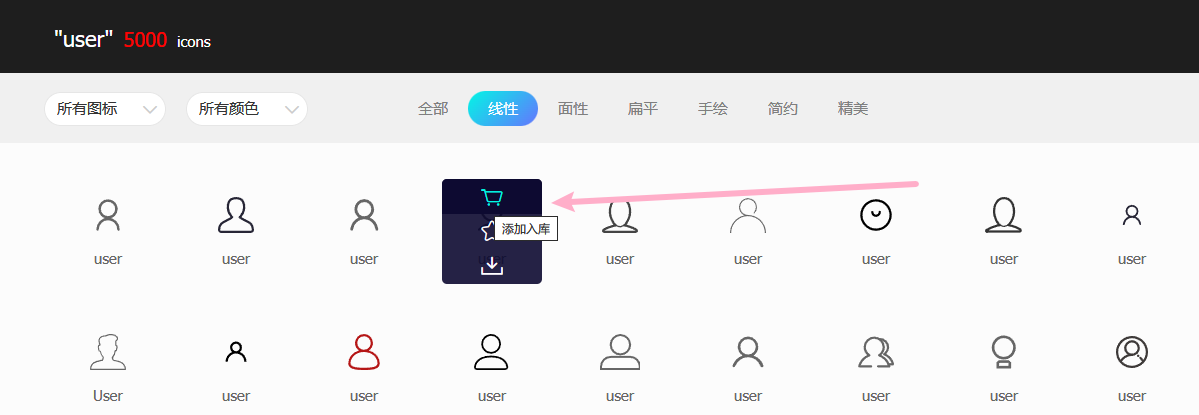
下载到本地:

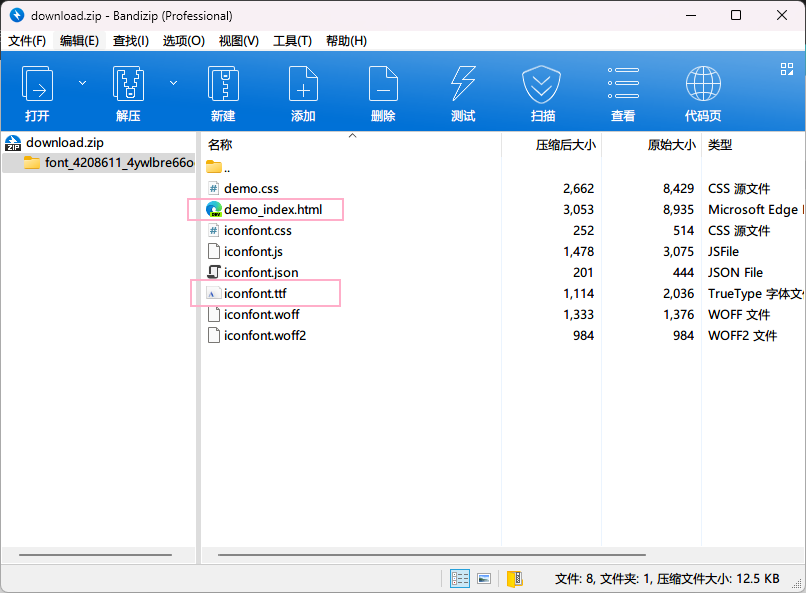
主要用上面勾选的两个文件,html文件是下载的图标演示,tff是程序中用到的字体文件了,把它放到新建的Assets资源文件夹下边:

之后就可以用了,Text内容可以从演示的html中找到,也可以在矢量图项目里面复制代码:
<TextBox Text="" FontFamily="./Assets/Fonts/#iconfont"/>

控件模板
模板内容因为只在这一个登录窗体上使用,就都定义在车Window.Resources窗体资源里了,所以看上去页面内容有点多,大家也可以单独定义资源文件。先说按钮,两个按钮都是通过自定义控件模板来完成的,关闭按钮主要是定义了一个 Path 控件,用于绘制一个 "X" 形状,类似于关闭按钮的图标,等率按钮就直接用 TextBlock 代替的:
<ControlTemplate x:Key="CloseButton" TargetType="Button"> <Border Name="back" Background="Transparent" CornerRadius="0,8,0,0"> <Path HorizontalAlignment="Center" VerticalAlignment="Center" Data="M0 0 12 12M0 12 12 0" Stroke="Black" StrokeThickness="1" /> </Border> <ControlTemplate.Triggers> <Trigger Property="IsMouseOver" Value="true"> <Setter TargetName="back" Property="Background" Value="red" /> </Trigger> </ControlTemplate.Triggers> </ControlTemplate> <ControlTemplate x:Key="LoginButton" TargetType="Button"> <Border Name="back" Background="{TemplateBinding Background}" CornerRadius="8"> <TextBlock Text="登录" VerticalAlignment="Center" HorizontalAlignment="Center"/> </Border> <ControlTemplate.Triggers> <Trigger Property="IsMouseOver" Value="true"> <Setter TargetName="back" Property="Background" Value="red"/> </Trigger> </ControlTemplate.Triggers> </ControlTemplate> 文本框也是通过自定义控件模板来完成的,只不过自己写东西有点多,所以是通过编辑模板给文本库框加的图标:
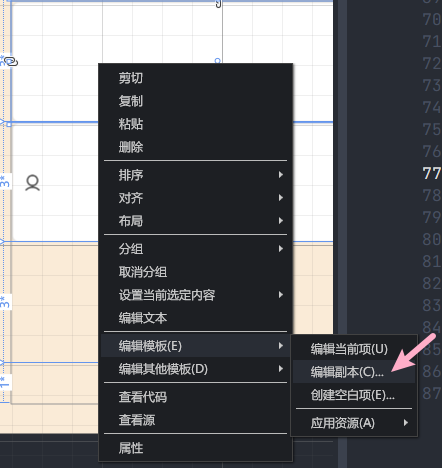

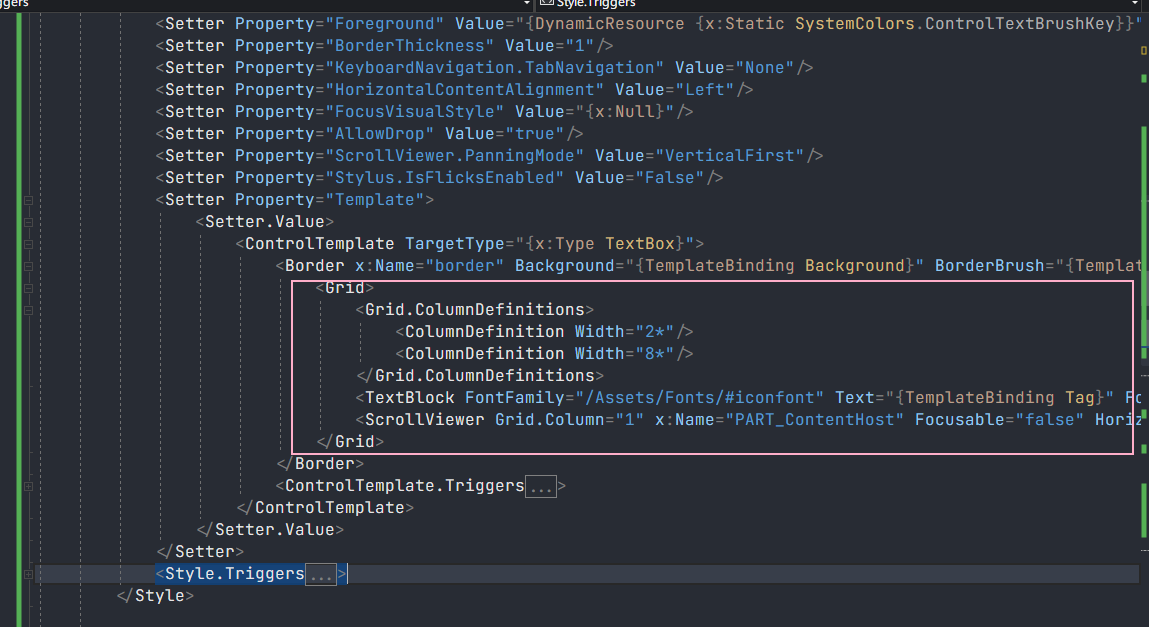
<Border x:Name="border" Background="{TemplateBinding Background}" BorderBrush="{TemplateBinding BorderBrush}" BorderThickness="{TemplateBinding BorderThickness}" SnapsToDevicePixels="True" CornerRadius="8"> <Grid> <Grid.ColumnDefinitions> <ColumnDefinition Width="2*"/> <ColumnDefinition Width="8*"/> </Grid.ColumnDefinitions> <TextBlock FontFamily="/Assets/Fonts/#iconfont" Text="{TemplateBinding Tag}" FontSize="20" VerticalAlignment="Center" HorizontalAlignment="Center" /> <ScrollViewer Grid.Column="1" x:Name="PART_ContentHost" Focusable="false" HorizontalScrollBarVisibility="Hidden" VerticalScrollBarVisibility="Hidden" VerticalAlignment="Center"/> </Grid> </Border> 图标属性因为Text属性要获取输入的文本,所以改成了通过文本框的 Tag 属性绑定内容。
而后的控件布局就不解释了吧,直接看代码吧:
MainView.xaml
<Window x:Class="MVVMDemo.MainView" xmlns="http://schemas.microsoft.com/winfx/2006/xaml/presentation" xmlns:x="http://schemas.microsoft.com/winfx/2006/xaml" xmlns:d="http://schemas.microsoft.com/expression/blend/2008" xmlns:local="clr-namespace:MVVMDemo" xmlns:mc="http://schemas.openxmlformats.org/markup-compatibility/2006" Title="MainView" Width="800" Height="450" AllowsTransparency="True" Background="{x:Null}" ResizeMode="NoResize" WindowStartupLocation="CenterScreen" WindowStyle="None" mc:Ignorable="d"> <Window.Resources> <ControlTemplate x:Key="CloseButton" TargetType="Button"> <Border Name="back" Background="Transparent" CornerRadius="0,8,0,0"> <Path HorizontalAlignment="Center" VerticalAlignment="Center" Data="M0 0 12 12M0 12 12 0" Stroke="Black" StrokeThickness="1" /> </Border> <ControlTemplate.Triggers> <Trigger Property="IsMouseOver" Value="true"> <Setter TargetName="back" Property="Background" Value="red" /> </Trigger> </ControlTemplate.Triggers> </ControlTemplate> <ControlTemplate x:Key="LoginButton" TargetType="Button"> <Border Name="back" Background="{TemplateBinding Background}" CornerRadius="8"> <TextBlock Text="登录" VerticalAlignment="Center" HorizontalAlignment="Center"/> </Border> <ControlTemplate.Triggers> <Trigger Property="IsMouseOver" Value="true"> <Setter TargetName="back" Property="Background" Value="red"/> </Trigger> </ControlTemplate.Triggers> </ControlTemplate> <SolidColorBrush x:Key="TextBox.Static.Border" Color="#FFABAdB3"/> <SolidColorBrush x:Key="TextBox.MouseOver.Border" Color="#FF7EB4EA"/> <SolidColorBrush x:Key="TextBox.Focus.Border" Color="#FF569DE5"/> <Style x:Key="IconTextBoxStyle" TargetType="{x:Type TextBox}"> <Setter Property="Background" Value="{DynamicResource {x:Static SystemColors.WindowBrushKey}}"/> <Setter Property="BorderBrush" Value="{StaticResource TextBox.Static.Border}"/> <Setter Property="Foreground" Value="{DynamicResource {x:Static SystemColors.ControlTextBrushKey}}"/> <Setter Property="BorderThickness" Value="1"/> <Setter Property="KeyboardNavigation.TabNavigation" Value="None"/> <Setter Property="HorizontalContentAlignment" Value="Left"/> <Setter Property="FocusVisualStyle" Value="{x:Null}"/> <Setter Property="AllowDrop" Value="true"/> <Setter Property="ScrollViewer.PanningMode" Value="VerticalFirst"/> <Setter Property="Stylus.IsFlicksEnabled" Value="False"/> <Setter Property="Template"> <Setter.Value> <ControlTemplate TargetType="{x:Type TextBox}"> <Border x:Name="border" Background="{TemplateBinding Background}" BorderBrush="{TemplateBinding BorderBrush}" BorderThickness="{TemplateBinding BorderThickness}" SnapsToDevicePixels="True" CornerRadius="8"> <Grid> <Grid.ColumnDefinitions> <ColumnDefinition Width="2*"/> <ColumnDefinition Width="8*"/> </Grid.ColumnDefinitions> <TextBlock FontFamily="/Assets/Fonts/#iconfont" Text="{TemplateBinding Tag}" FontSize="20" VerticalAlignment="Center" HorizontalAlignment="Center" /> <ScrollViewer Grid.Column="1" x:Name="PART_ContentHost" Focusable="false" HorizontalScrollBarVisibility="Hidden" VerticalScrollBarVisibility="Hidden" VerticalAlignment="Center"/> </Grid> </Border> <ControlTemplate.Triggers> <Trigger Property="IsEnabled" Value="false"> <Setter Property="Opacity" TargetName="border" Value="0.56"/> </Trigger> <Trigger Property="IsMouseOver" Value="true"> <Setter Property="BorderBrush" TargetName="border" Value="{StaticResource TextBox.MouseOver.Border}"/> </Trigger> <Trigger Property="IsKeyboardFocused" Value="true"> <Setter Property="BorderBrush" TargetName="border" Value="{StaticResource TextBox.Focus.Border}"/> </Trigger> </ControlTemplate.Triggers> </ControlTemplate> </Setter.Value> </Setter> <Style.Triggers> <MultiTrigger> <MultiTrigger.Conditions> <Condition Property="IsInactiveSelectionHighlightEnabled" Value="true"/> <Condition Property="IsSelectionActive" Value="false"/> </MultiTrigger.Conditions> <Setter Property="SelectionBrush" Value="{DynamicResource {x:Static SystemColors.InactiveSelectionHighlightBrushKey}}"/> </MultiTrigger> </Style.Triggers> </Style> </Window.Resources> <Border Margin="5" Background="AntiqueWhite" CornerRadius="8"> <Border.Effect> <DropShadowEffect BlurRadius="5" Direction="0" Opacity="0.3" ShadowDepth="0" Color="Gray" /> </Border.Effect> <Grid> <Grid.ColumnDefinitions> <ColumnDefinition Width="6*" /> <ColumnDefinition Width="4*" /> </Grid.ColumnDefinitions> <Border CornerRadius="8,0,0,8"> <Border.Background> <ImageBrush ImageSource="./Assets/Images/LoginBackground.png" Stretch="Fill" /> </Border.Background> </Border> <Border Grid.Column="1" CornerRadius="0,8,0,8"> <Grid> <Grid.RowDefinitions> <RowDefinition Height="3*" /> <RowDefinition Height="7*" /> </Grid.RowDefinitions> <StackPanel> <Button Width="30" Height="30" HorizontalAlignment="Right" Template="{StaticResource ResourceKey=CloseButton}" /> <TextBlock Margin="15" HorizontalAlignment="Center" VerticalAlignment="Center" FontSize="26" Foreground="Black" Text="图书管理系统" /> <TextBlock Margin="5" HorizontalAlignment="Center" FontSize="16" Text="MVVM示例Demo" /> </StackPanel> <Grid Grid.Row="1" Margin="20,20"> <Grid.RowDefinitions> <RowDefinition Height="3*" /> <RowDefinition Height="3*" /> <RowDefinition Height="3*" /> <RowDefinition Height="1*" /> </Grid.RowDefinitions> <TextBox Style="{DynamicResource IconTextBoxStyle}" Tag="" Height="60" FontSize="15"/> <TextBox Grid.Row="1" Style="{DynamicResource IconTextBoxStyle}" Tag="" Height="60" FontSize="15" /> <Button Grid.Row="2" Width="200" Height="50" Template="{StaticResource LoginButton}" Background="Blue" Foreground="White" FontSize="20"/> </Grid> </Grid> </Border> </Grid> </Border> </Window> 这是登录页面,登录成功后的页面随便写个吧:handyControlView,尝鲜一下HandyControl:
先安装HandyControl:
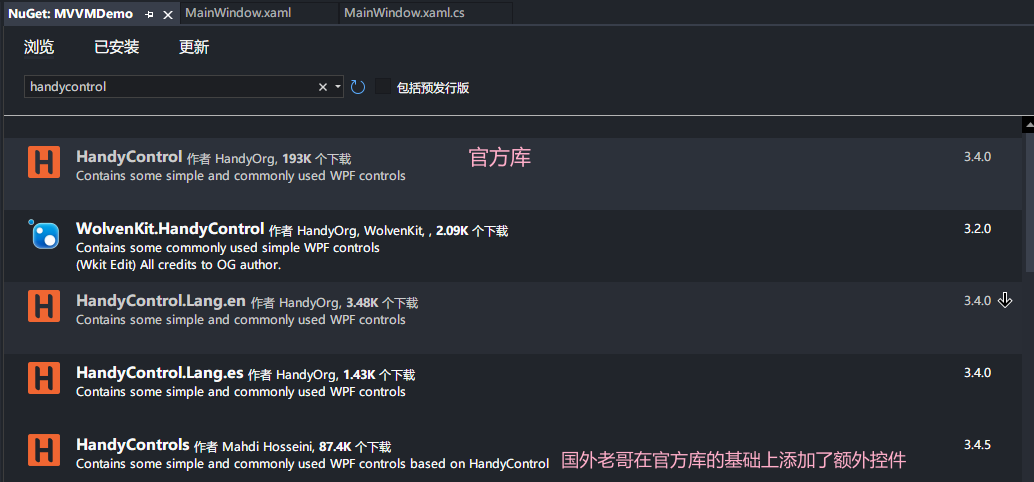
在App.xaml中添加HandyControl资源字典:
<Application.Resources> <ResourceDictionary> <ResourceDictionary.MergedDictionaries> <ResourceDictionary Source="pack://application:,,,/HandyControl;component/Themes/SkinDefault.xaml"/> <ResourceDictionary Source="pack://application:,,,/HandyControl;component/Themes/Theme.xaml"/> </ResourceDictionary.MergedDictionaries> </ResourceDictionary> </Application.Resources> </Application> 引入命名空间: xmlns:hc="https://handyorg.github.io/handycontrol",之后使用引用对应样式就可以了:

HandyControl分原生控件和拓展控件,原生控件是在WPF原生控件的基础上做了美化,本质功能是一样的,拓展控件则是原生控件中没有的,比如可以播放Gif动图的GifImage,我就看看原生控件了,扩展控件等专门用的时候再研究:
<Window x:Class="MVVMDemo.handyControlView" xmlns="http://schemas.microsoft.com/winfx/2006/xaml/presentation" xmlns:x="http://schemas.microsoft.com/winfx/2006/xaml" xmlns:d="http://schemas.microsoft.com/expression/blend/2008" xmlns:mc="http://schemas.openxmlformats.org/markup-compatibility/2006" xmlns:controls="https://handyorg.github.io/handycontrol" xmlns:local="clr-namespace:MVVMDemo" mc:Ignorable="d" Title="handyControlView" Height="450" Width="800"> <Grid> <StackPanel> <Label Content="LabelDanger样式" Margin="10" Style="{DynamicResource LabelDanger}"></Label> <Button Content="Button" Style="{StaticResource ButtonPrimary}"/> <Button Content="这是一个按钮" Margin="10,0,0,0" controls:BorderElement.CornerRadius="15"/> <CheckBox Content="CheckBox" IsChecked="True"/> <CheckBox Margin="0,16,0,0" Content="CheckBox" IsChecked="True" IsEnabled="False"/> <CheckBox Margin="0,16,0,0" Content="CheckBox" IsChecked="{x:Null}"/> <Slider VerticalAlignment="Center" Width="400" Value="40" Maximum="100"/> <TextBox Width="200" VerticalAlignment="Center"/> <RadioButton Content="默认样式"/> <RadioButton Margin="0,16,0,0" Content="不可编辑" IsChecked="True" IsEnabled="False"/> <StackPanel Margin="20"> <TextBlock Text="ProgressBarSuccess"></TextBlock> <ProgressBar Style="{DynamicResource ProgressBarSuccess}" Value="40"></ProgressBar> </StackPanel> <StackPanel Margin="20"> <TextBlock Text="ProgressBarInfo"></TextBlock> <ProgressBar Style="{DynamicResource ProgressBarInfo}" Value="40"></ProgressBar> </StackPanel> </StackPanel> </Grid> </Window> 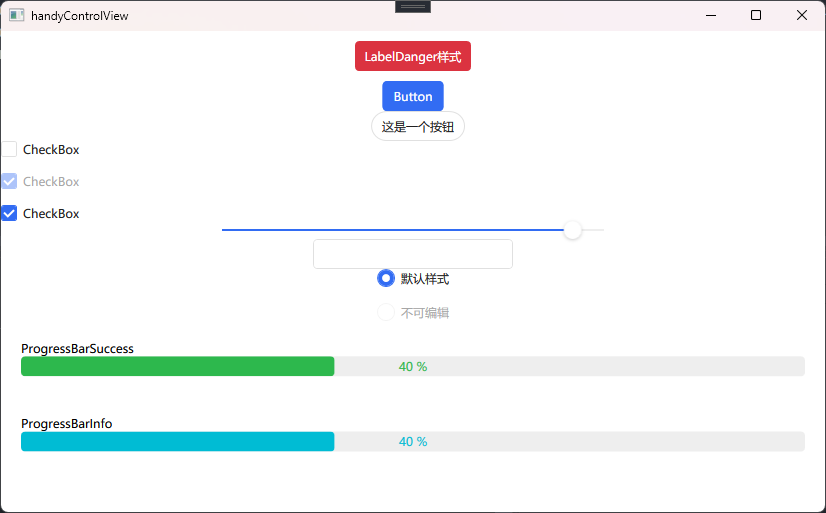
页面逻辑
不使用MVVM
在不使用MVVM情况下实现点击登录:点击登录按钮获取输入的用户名密码,验证是否正确,正确则创建页面隐藏当前页:
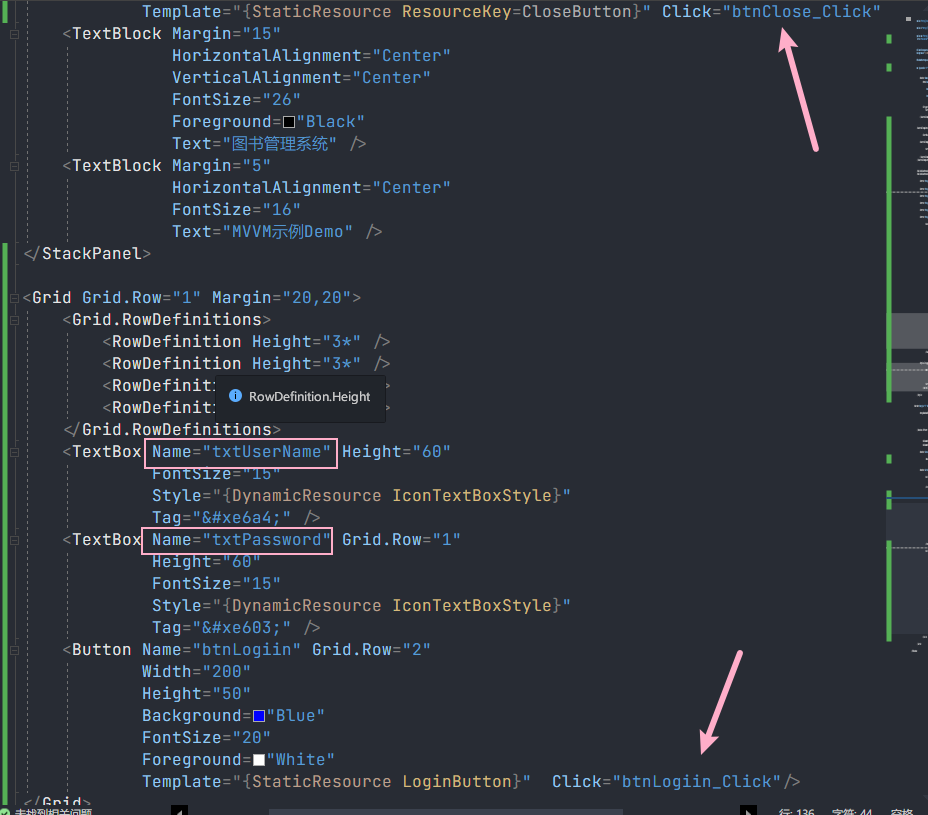
private void btnLogiin_Click(object sender, RoutedEventArgs e) { if (txtUserName.Text == "Cass" && txtPassword.Text == "12136") { handyControlView handyControlView = new handyControlView(); handyControlView.Show(); this.Close(); } else { MessageBox.Show("用户名或密码错误。"); } } private void btnClose_Click(object sender, RoutedEventArgs e) { this.Close(); } 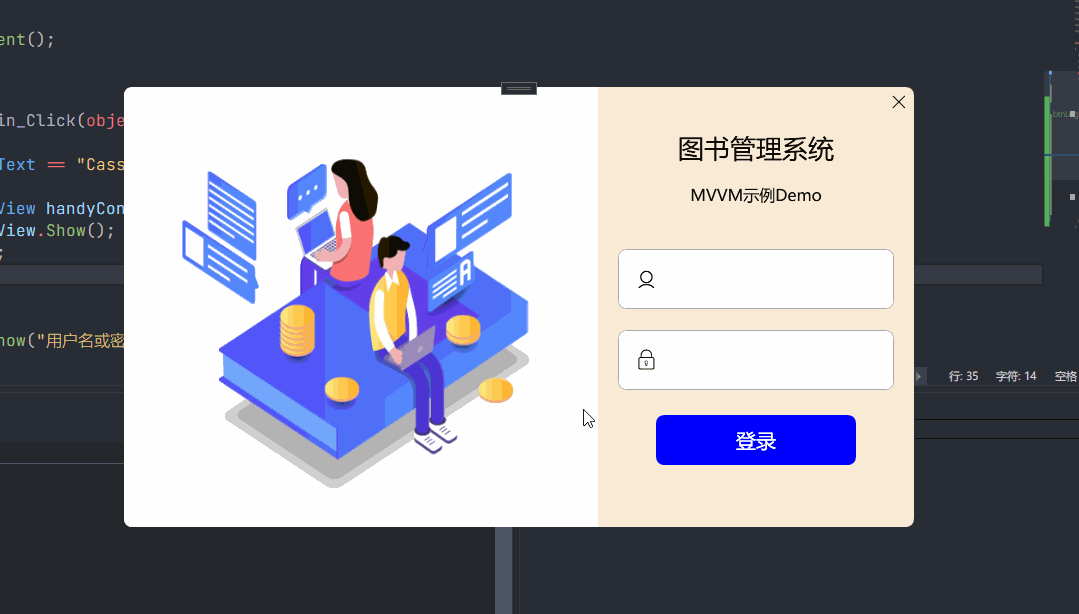
现在所有东西是耦合在一起的,虽然这样看起来实现起来比较快,但是在后期维护起来是非常麻烦的,尤其是?⛰️工程,假如其中任何一个环节发生了变化,程序就会出问题,简而言之就是牵一发而动全身。
接下来看一下MVVM模式下的实现:
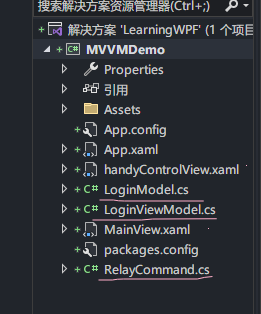
Model部分
这部分主要是登录页面的数据部分,涉及两个字段,用户名和密码:
LoginModel.cs:
namespace MVVMDemo { public class LoginModel { private string _UserName; public string UserName { get { return _UserName; } set { _UserName = value; } } private string _Password; public string Password { get { return _Password; } set { _Password = value; } } } } View部分
视图部分主要做数据的呈现,通过绑定和命令解耦图形界面和数据以及执行动作之间的关系,数据之间的交互在用户名和密码文本框:
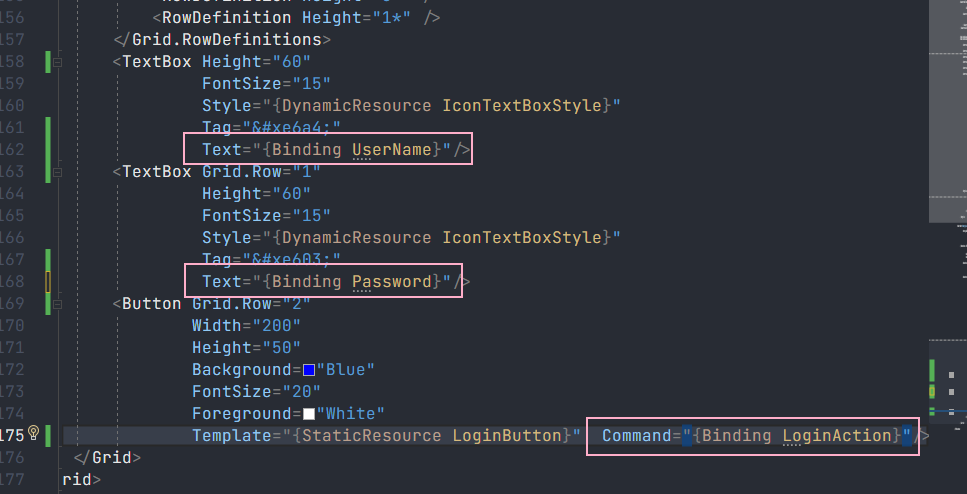
动作有两个,一个是关闭按钮,另一个是登录按钮。关闭按钮只是关闭当前窗体,不涉及业务交互,所以保留之前的Click事件即可,登录按钮就涉及到视图、数据以及业务逻辑了,这就需要通过命令来完成。
ViewModel部分
在这之前需要完成命令接口的定义,新建一个文件:RelayCommand.cs实现ICommand接口:
using System; using System.Windows.Input; namespace MVVMDemo { public class RelayCommand : ICommand { private readonly Action _execute; // 需要执行的操作(命令体) private readonly Func<bool> _canExecute; // 命令是否可以执行的逻辑 public RelayCommand(Action action, Func<bool> canExecute) { _execute = action; _canExecute = canExecute; } public bool CanExecute(object parameter) // ICommand接口方法之一,用于判断命令是否可以执行 { if (_canExecute == null) { return true; // 命令始终可以执行 } else { return _canExecute(); // 调用 _canExecute() 获取判断结果 } } public void Execute(object parameter) // ICommand接口方法之一 用于执行命令体,调用 _execute 所存储的操作 { _execute?.Invoke(); } public event EventHandler CanExecuteChanged // ICommad接口中的事件,当命令的可执行状态发生变化时,触发此事件来通知界面元素更新 { add { if (_canExecute != null) { CommandManager.RequerySuggested += value; } } remove { if (_canExecute != null) { CommandManager.RequerySuggested -= value; } } } } } 这样就完成了命令接口的实现,接着来看ViewModel视图模型,视图模型作为沟通数据Model和视图View之间的桥梁,就得多干一些活了。首先是数据部分,为了更好的解耦,不让图形界面与数据产生直接交互,在ViewModel里嵌套一层在获取Model以及View部分的数据并完成验证处理、数据更新还有命令操作:
LoginViewModel.cs:
using System.ComponentModel; using System.Runtime.CompilerServices; using System.Windows; using System.Windows.Input; namespace MVVMDemo { public class LoginViewModel : INotifyPropertyChanged { public event PropertyChangedEventHandler PropertyChanged; // INotifyPropertyChanged接口事件,用于在属性更改时发出通知 private LoginModel _loginModel; private MainView _mainView; public LoginViewModel(MainView mainView) { _loginModel = new LoginModel(); _mainView = mainView; } // 绑定到登录界面文本框的属性,用于获取和设置用户名和密码 public string UserName { get { return _loginModel.UserName; } set { _loginModel.UserName = value; OnPropertyChanged(UserName); } } public string Password { get { return _loginModel.Password; } set { _loginModel.Password = value; OnPropertyChanged(Password); } } protected virtual void OnPropertyChanged([CallerMemberName] string propertyName = null) // 触发属性更改通知的方法 { PropertyChanged?.Invoke(this, new PropertyChangedEventArgs(propertyName)); } private void LoginFunc() // 处理登录操作 { if (UserName == "Cass" && Password == "12136") { handyControlView handyControlView = new handyControlView(); handyControlView.Show(); _mainView.Close(); } else { MessageBox.Show("用户名或密码错误"); UserName = ""; Password = ""; } } private bool CanLoginExecute() { return true; } public ICommand LoginAction // 绑定到登录按钮的命令属性 { get { return new RelayCommand(LoginFunc, CanLoginExecute); //(执行体,判断条件) } } } } 完成了沟通部分的桥梁怎样,和其他两部分取得练习呢?数据部分,通过属性更新已经通知到了,视图部分就需要通过绑定数据上下文来完成了:
Mainview.xaml.cs
using System.Windows; namespace MVVMDemo { /// <summary> /// MainWindow.xaml 的交互逻辑 /// </summary> public partial class MainView : Window { public MainView() { InitializeComponent(); this.DataContext = new LoginViewModel(this); } private void btnClose_Click(object sender, RoutedEventArgs e) { this.Close(); } } } ?完结撒花
以上一个简单的MVVM示例就完成了,怎么说呢,虽然看着很简单,代码也没多少,但是对初学者来说绝非易事。还有一件事想要告诉大家,学习过程中一定不要只看不写,在学习过程中,实践是非常重要的。阅读和理解代码的同时,动手编写代码是巩固知识的关键部分。即使在完成这篇博文的过程中,我仍有新的收获在里面,所以大家千万不要只看,纸上谈兵永远都是空谈?。
希望可以给大家一点参考,有错误的部分还请在评论区指出。




